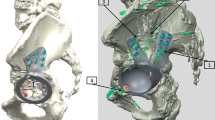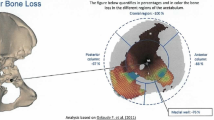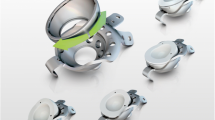Abstract
The aim of the present study was to analyze the clinical and radiographic outcomes and Kaplan–Meier survivorship of patients who underwent revision surgeries of the acetabular cup that had sustained aseptic loosening. We reviewed 101 consecutive patients (120 hips; 10 men 11 hips; 91 women 109 hips; age at surgery 66 years; range 45–85) who underwent acetabular component revision surgery, at a follow-up period of 15.6 years (range 10–32). To evaluate the state of the acetabulum, acetabular bony defects were classified according to the AAOS classification based on intraoperative findings: type I (segmental deficiencies n = 24 hips), type II (cavity deficiency n = 48), type III (combined deficiency n = 46), and type IV (pelvic discontinuity n = 2). The Harris hip score improved from 42.5 ± 10.8 (mean ± SD) before surgery to 74.9 ± 14.6 points at follow-up. The survival rates of the acetabular revision surgery with cemented, cementless, and cemented cups plus reinforcement devices were 74, 66, and 82 %, respectively. The difference in the survival rate between the cemented and cementless group was marginal (p = 0.048 Gehan–Breslow–Wilcoxon, p = 0.061 log-rank), probably due to the early-stage failure cases in the cementless group. The cementless and reinforcement groups included nine early-stage failure cases. To prevent early-stage failure, we recommend the cementless cups for types I and II acetabular bone defects with adequate contact between host bone and acetabular component, and the cemented cup with or without reinforcement devices, together with restoration of bone stock by impaction or structured bone grafting, for cases lacking such contact.




Similar content being viewed by others
References
Ando M, Imura S, Omori H, Okumura Y, Bo A, Baba H (1999) Nonlinear three-dimensional finite element analysis of newly designed cementless total hip stems. Artif Organs 23:339–346
Kawahara H, Kokubo Y, Yayama T, Uchida K, Kobayashi S, Nakajima H, Oki H, Negoro K, Mwaka ES, Orwotho NT, Baba H (2010) Metaphyseal-loading anterolaterally-flared femoral stem in cementless total hip arthroplasty: five- to eleven-year follow-up evaluation. Artif Organs 34:377–383
Kokubo Y, Uchida K, Oki H, Negoro K, Nagamune K, Kawaguchi S, Takeno K, Yayama T, Nakajima H, Sugita D, Yoshida A, Baba H (2013) Modified metaphyseal-loading anterolaterally flared anatomic femoral stem: five- to nine-year prospective follow-up evaluation and results of three-dimensional finite element analysis. Artif Organs 37:175–182
Kremers HM, Howard JL, Loechler Y, Schleck CD, Harmsen WS, Berry DJ, Cabanela ME, Hanssen AD, Pagnano MW, Trousdale RT, Lewallen DG (2012) Comparative long-term survivorship of uncemented acetabular components in revision total hip arthroplasty. J Bone Joint Surg 94A:e82
Kurtz S, Ong K, Lau E, Mowat F, Halpern M (2007) Projections of primary and revision hip and knee arthroplasty in the United States from 2005 to 2030. J Bone Joint Surg 89A:780–785
Trumm BN, Callaghan JJ, George CA, Liu SS, Goetz DD, Johnston RC (2014) Minimum 20-year follow-up results of revision total hip arthroplasty with improved cementing technique. J Arthroplasty 29:236–241
Schreurs BW, Luttjeboer J, Thien TM, de Waal Malefijt MC, Buma P, Veth RP, Slooff TJ (2009) Acetabular revision with impacted morselized cancellous bone graft and a cemented cup in patients with rheumatoid arthritis. A concise follow-up, at eight to nineteen years, of a previous report. J Bone Joint Surg 91A:646–651
Sternheim A, Abolghasemian M, Safir OA, Backstein D, Gross AE, Kuzyk PR (2013) A long-term survivorship comparison between cemented and uncemented cups with shelf grafts in revision total hip arthroplasty after dysplasia. J Arthroplasty 28:303–308
Trumm BN, Callaghan JJ, Liu SS, Goetz DD, Johnston RC (2012) Revision with cementless acetabular components: a concise follow-up, at a minimum of twenty years, of previous reports. J Bone Joint Surg 94A:2001–2004
Kim KC, Ha YC, Kang BJ, Lee YK, Ji HM, Koo KH (2012) Use of cementless acetabular component with a hook and iliac flanges in revision arthroplasty for massive acetabular defect. J Orthop Sci 17:18–24
Gustke KA, Levering MF, Miranda MA (2014) Use of jumbo cups for revision of acetabulae with large bony defects. J Arthroplasty 29:199–203
Lachiewicz PF, Soileau ES (2013) Fixation, survival, and dislocation of jumbo acetabular components in revision hip arthroplasty. J Bone Joint Surg 95A:543–548
Wegrzyn J, Pibarot V, Jacquel A, Carret JP, Béjui-Hugues J, Guyen O (2014) Acetabular reconstruction using a Kerboull cross-plate, structural allograft and cemented dual-mobility cup in revision THA at a minimum 5-year follow-up. J Arthroplasty 29:432–437
Stöckl B, Beerkotte J, Krismer M, Fischer M, Bauer R (1997) Results of the Müller acetabular reinforcement ring in revision arthroplasty. Arch Orthop Trauma Surg 116:55–59
Kawanabe K, Akiyama H, Onishi E, Nakamura T (2007) Revision total hip replacement using the Kerboull acetabular reinforcement device with morsellised or bulk graft: results at a mean follow-up of 8.7 years. J Bone Joint Surg 89B:26–31
Patel S, Sukeik M, Haddad FS (2013) Initial implant stability predicts migration but not failure in cementless acetabular revision with bone grafting. J Arthroplasty 28:832–837
van Haaren EH, Heyligers IC, Alexander FG, Wuisman PI (2007) High rate of failure of impaction grafting in large acetabular defects. J Bone Joint Surg 89B:296–300
Pereira GC, Kubiak EN, Levine B, Chen FS, Di Cesare PE (2007) Cavitary acetabular defects treated with morselized cancellous bone graft and cementless cups. Int Orthop 31:445–450
D’Antonio JA, Capello WN, Borden LS, Bargar WL, Bierbaum BF, Boettcher WG, Steinberg ME, Stulberg SD, Wedge JH (1989) Classification and management of acetabular abnormalities in total hip arthroplasty. Clin Orthop Relat Res 243:126–137
DeLee JG, Charnley J (1976) Radiological demarcation of cemented sockets in total hip replacement. Clin Orthop Relat Res 121:20–32
Nakashima Y, Sato T, Yamamoto T, Motomura G, Ohishi M, Hamai S, Akiyama M, Hirata M, Hara D, Iwamoto Y (2013) Results at a minimum of 10 years of follow-up for AMS and PerFix HA-coated cementless total hip arthroplasty: impact of cross-linked polyethylene on implant longevity. J Orthop Sci 18:962–968
Author’s contribution
YK designed the study. YK drafted the manuscript. YK and HO performed surgical treatment. KN, KT, TM, and HN performed managed the clinical and radiological evaluation. DS performed statistical analysis.
Author information
Authors and Affiliations
Corresponding author
Ethics declarations
Conflict of interest
All authors declare no conflict of interest.
Ethical approval
All procedures performed in this report were in accordance with the ethical standards of the institutional and/or national research committee and with the 1964 Helsinki Declaration and its later amendments or comparable ethical standards.
Informed consent
Informed consent was obtained from all individual participants included in the study.
Rights and permissions
About this article
Cite this article
Kokubo, Y., Oki, H., Sugita, D. et al. Long-term clinical outcome of acetabular cup revision surgery: comparison of cemented cups, cementless cups, and cemented cups with reinforcement devices. Eur J Orthop Surg Traumatol 26, 407–413 (2016). https://doi.org/10.1007/s00590-016-1763-1
Received:
Accepted:
Published:
Issue Date:
DOI: https://doi.org/10.1007/s00590-016-1763-1




